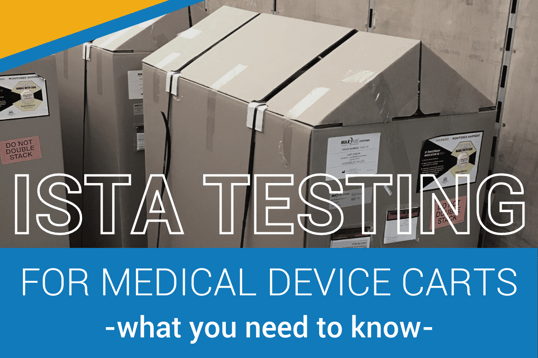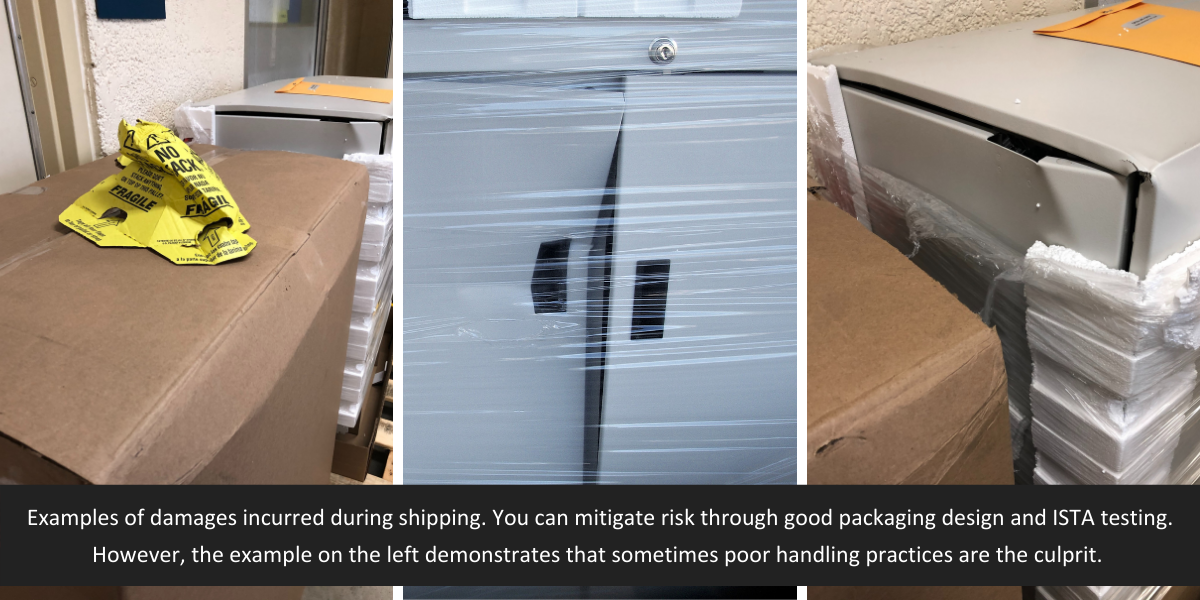In the medical device cart industry, we are very focused on testing our products for a number of reasons. We cycle test our devices to verify that they will withstand the rigors of long-term use, and we also test for regulatory compliance. There's one more round of testing that is very important to our process at HUI: testing our packaging configurations through ISTA testing.
ISTA testing stands for “International Safe Transit Association”, the organization that provides packaging testing to various industries to make sure packages are prepped properly to withstand shipping conditions and get to their destination intact.

Who provides ISTA testing for medical carts?
ISTA testing occurs at certified testing sites. Oftentimes large packaging companies offer on-site testing. At HUI we partner with our packaging supplier to conduct the certified testing at their facility, which is within 50 miles of our location. If you need to find an ISTA certified testing lab, you can use the ISTA website directory or talk to your medical device cart manufacturer to get a recommendation.
It is typical for many large packaging companies to have their own testing lab on-site. We work with our packaging company near to our facility that does the ISTA testing on our customer’s products.
Certain labs may have different levels of testing available at a particular site. If you need very specialized testing, you may have to find a facility that will provide that specific type of test.
The ISTA process will simulate conditions that the packaged cart or device may experience in shipping. Then, the packaging and the cart itself will both be inspected for signs of damage. Based on these tests, there may be recommendations made for modifications to the packaging to better protect the item.
When is ISTA testing conducted during the medical cart design and production process?
Packaging testing typically occurs once all revisions and modifications are completed from the prototyping process. Once there is a final medical cart approved and the packaging has been designed, the packaged cart can be sent to a lab for ISTA testing.
We always have our carts tested in the configuration that they will be shipped back to our device manufacturer customers. One smart thing some of our customers request is for us to mount the device to the cart in the final configuration in which it will be sent to the end-user. This way, the packaging can be tested just once to reveal any issues that may occur in shipping.
Which testing procedures do you typically use to test your medical device cart packaging?
The ISTA outlines an entire menu of testing options for different sizes and types of packaging. The specific procedure required depends on the size, weight, and configuration of the package and the shipping circumstances and type of material handler that will transport the medical cart or medical device system. Some of the most common procedures we recommend for ISTA testing are Procedure 2B (Packaged-Products weighing over 150lb) and Procedure 3B (Less-Than-Truckload Shipment). We highly recommend working with your medical cart manufacturer and the testing facility to determine the testing procedure that will best replicate actual future shipping conditions in advance.
For more information about the different test procedures and what each procedure includes, see the ISTA website’s Test Procedures Page.
What does ISTA testing involve?
During ISTA testing, packaged items are put through a series of tests that simulate environmental factors, movement, or impacts that may occur in shipping. It’s important that the item, in our case a medical device cart, is packaged exactly as it will be for shipment. Depending on the package and how it will be shipped, there are different levels of testing that a package may undergo. The ISTA tests that our medical cart packages most typically undergo are 1B, 2B, and 3B.
Let’s look at one testing series that our cart packages typically undergo during our packaging testing.
In procedure 2B, the package undergoes:
- Atmospheric testing, in which the package is exposed to varying levels of heat, cold, and humidity to test the integrity of the package itself and any protection offered to component pieces that may be heat, moisture, or cold-sensitive.
- Compression, in which hydraulic plates press on the package to determine how packages hold up to top loading and stacking.
- Vibration, in which the package is placed in its normal shipping position and subjected to vibration for an extended period.
- Horizontal impact testing, in which the package is subjected to impacts on all sides in the vertical position to simulate another item hitting the side of the package.
- Handling/dropping, in which one edge is raised a short set distance off the ground and then dropped to simulate being dropped during handling.
After the testing is completed, the package or crate is examined for signs of damage. When testing new packaging, our engineers sometimes go to the testing facility to open the package and inspect the product itself immediately following the testing. It is important to note that even if there are no visible signs of damage to the exterior of the crate or palletized load, the product inside can incur damage.

Important Medical Device Cart Packaging Testing Lessons Learned:
- Passing the test is not a guarantee. Testing provides a simulated environment designed to mimic conditions that may take place during the shipping and handling of your medical cart. However, there is no way to predict whether the individual driver or material handler that moves your package will adhere to the handling instructions! Many of the shipping disasters we’ve witnessed were a result of poor handling rather than poor packaging design or lack of testing.
- If testing fails, you may need to go back to the drawing board and re-design the packaging by adding stabilization and protection to the pack. In some cases, the cart or device itself is just not robust enough and there may be small modifications to the actual design to build a cart that can withstand more handling.
- Packaging doesn’t just protect the product. It’s also the first tangible experience your end-user has with your brand. You’ve probably worked countless hours to build a relationship with your customers, and they’ve made a significant investment in the medical equipment they have purchased from you. It’s important that the brand experience extends through unloading that package. Some of our customers wrap the outside of their package in a branded sheath or have other branding included in the packaging design. ISTA testing can reveal vulnerabilities of the packaging to damage that can give a poor impression. If the box or crate is banged up or dinged, they might not trust the integrity of what’s inside. In order to protect your brand and protect your product, ISTA is testing is the way to go.
If you have questions about ISTA testing, please reach out! We’d love to help educate your product team or have a conversation about your options.
